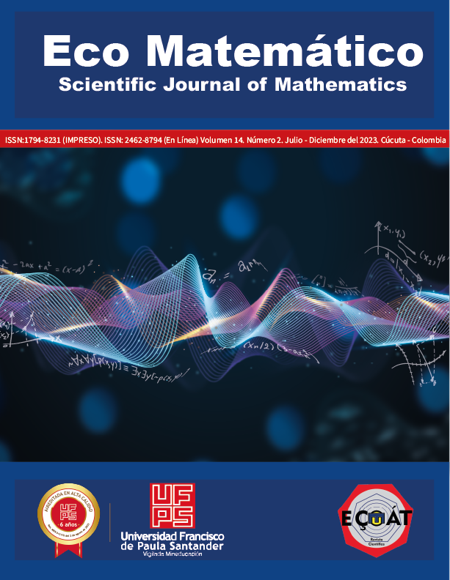Evaluación de la consistencia y la estructura factorial de una escala de emociones hacia las Matemáticas
Evaluation of the Consistency and Factor Structure of an Emotions Towards Mathematics Scale
Contenido principal del artículo
El presente estudio enfatizó la relevancia de entender las emociones de los estudiantes hacia las matemáticas, dada la considerable influencia que estas podrían tener en su proceso de aprendizaje y en su rendimiento en dicha disciplina (Autor, año). El propósito central de la investigación fue validar un instrumento concebido para cuantificar estas emociones, evaluando, por ende, su fiabilidad, consistencia interna y estructura factorial. Para alcanzar dicho objetivo, se adoptó una metodología cuantitativa, implementando un diseño de investigación descriptivo y correlacional. Se contó con una muestra de 1039 estudiantes, seleccionados aleatoriamente de instituciones educativas situadas en el área metropolitana de Cúcuta, Colombia. Los participantes, con edades entre 16 y 18 años, presentaron una distribución de género equitativa. La evaluación de las emociones se efectuó mediante un cuestionario de 10 ítems, el cual fue desarrollado con base en investigaciones previas y orientado específicamente a medir las emociones de los estudiantes hacia las matemáticas (Autor, año). La fiabilidad del instrumento se examinó mediante el coeficiente Alfa de Cronbach, arrojando un valor aceptable. Los análisis evidenciaron la presencia de dos factores preponderantes: "Satisfacción hacia las Matemáticas" e "Inseguridad hacia las Matemáticas", explicando conjuntamente el 53% de la varianza en los datos. Estos factores delinearon emociones positivas y negativas hacia las matemáticas, respectivamente, y se manifestaron como entidades independientes entre sí, mostrando una correlación baja y ausencia de significación estadística. En la discusión se recalcó la importancia de la autonomía de los factores hallados, sugiriendo que las emociones positivas y negativas hacia las matemáticas no están fuertemente interrelacionadas en la muestra examinada (Autor, año). Se destacó la complejidad de abordar dichas emociones de forma diferenciada en el ámbito educativo y se puso de relieve la imperatividad de tener en cuenta el contexto cultural y geográfico específico de Cúcuta en investigaciones futuras.
Descargas
Detalles del artículo
Ashcraft, M. H., & Moore, A. M. (2009). Mathematics Anxiety and the Affective Drop in Performance. Journal of Psychoeducational Assessment, 27(3), 197–205. DOI: https://doi.org/10.1177/0734282908330580
Arnau, A., & Sellas, I. (2017). Las emociones de los estudiantes de magisterio en relación a los procesos de enseñanza y aprendizaje de las ciencias y de las matemáticas. Enseñanza de las Ciencias, (Ext), 2053-5058.
Auzmendi, E. (1992). Las actitudes hacia la matemática-estadística en las enseñanzas medias y universitarias. Mensajero.
Bandura, A. (1986). Los fundamentos sociales del pensamiento y acción. Prentice Hall.
Bartlett, M. S. (1954). A Note on the Multiplying Factors for Various χ2 Approximations”, Journal of the Royal Statistical Society. Series B (Methodological), 16(2), 296-298. DOI: https://doi.org/10.1111/j.2517-6161.1954.tb00174.x
Beilock, S. L., & Maloney, E. A. (2015). Math Anxiety: A Factor in Math Achievement Not to Be Ignored. Policy Insights from the Behavioral and Brain Sciences, 2(1), 4-12. DOI: https://doi.org/10.1177/2372732215601438
Bell, J., & Waters, S. (2014). Doing Your Research Project: A Guide for First-Time Researchers. McGraw-Hill Education.
Bishop, A. J. (1988). Mathematical enculturation: A cultural perspective on mathematics education. Kluwer Publication.
Blanco, L., Caballero, A., & Piedehierro, A., Guerrero, E., & Gómez, R. (2010). El Dominio afectivo en la Enseñanza/Aprendizaje de las Matemáticas. Una revisión de investigaciones locales. Campo Abierto, 29(1), 13-31.
Bloom, B. S. (1956). Taxonomy of educational objectives: The classification of educational goals: Handbook I, cognitive domain. Longmans, Green.
Boaler, J. (2015). Mathematical Mindsets: Unleashing Students' Potential through Creative Math, Inspiring Messages and Innovative Teaching. Jossey-Bass.
Brown, T. A. (2015). Confirmatory factor analysis for applied research (2nd Ed.). The Guilford Press.
Byrne, B. M. (2016). Structural Equation Modeling with AMOS. Basic Concepts, Applications, and Programmin. Routledge. DOI: https://doi.org/10.4324/9781315757421
Caballero, A., & Blanco, L. J. (2007). Las actitudes y emociones ante las Matemáticas de los estudiantes para Maestros de la Facultad de Educación de la Universidad de Extremadura. Comunicación presentada en el Grupo de Trabajo “Conocimiento y desarrollo profesional del profesor. XI SEIEM. Simposio de Investigación y Educación Matemática, La Laguna.
Carpenter, T., & Fennema, E. (1992). Cognitively guided instruction: Building on the knowledge of students and teachers. International Journal of Research in Education, 17, 457-470. DOI: https://doi.org/10.1016/S0883-0355(05)80005-9
Casis, M., Rico, N., & Castro, E. (2017). Motivación, autoconfianza y ansiedad como descriptores de la actitud hacia las matemáticas de los futuros profesores de educación básica de Chile. PNA, 11(3), 181-203. DOI: https://doi.org/10.30827/pna.v11i3.6073
Cattell, R. B. (1966). The Scree Test For The Number Of Factors. Multivariate Behav Res, 1(2), 245-76. DOI: https://doi.org/10.1207/s15327906mbr0102_10
Cattell, R. B. (1978). The Scientific Use of Factor Analysis in Behavioral and Life Sciences. Plenum. DOI: https://doi.org/10.1007/978-1-4684-2262-7
Coca, A. (2016). Estudio de las emociones y su persistencia en la clase de matemáticas usando un enfoque cognitivo. En A. M. Rosas (Ed.), Avances en Matemática Educativa. Tecnología y matemáticas (pp. 17-31). Editorial Lectorum, S. A. de C.V.
Cohen, L., Manion, L., & Morrison, K. (2013). Research methods in education. Routledge. DOI: https://doi.org/10.4324/9780203720967
Costello, A. B., & Osborne, J. W. (2005). Best practices in exploratory factor analysis: Four recommendations for getting the most from your analysis. Practical Assessment, Research & Evaluation, 10(7), 1-9.
Creswell, J. W. (2014). Research design: Qualitative, quantitative, and mixed methods approaches. SAGE Publications.
Cronbach, L. J. (1951). Coefficient alpha and the internal structure of tests. Psychometrika, 16(3), 297-334. DOI: https://doi.org/10.1007/BF02310555
Darren, G., & Mallery, P. (2003). SPSS for Windows Step by Step: A Simple Guide and Reference, 11.0 Update (4th Ed.). Allyn & Bacon.
DeBellis, V. A., & Goldin, G. A. (2006). Affect and Meta-Affect in Mathematical Problem Solving: A Representational Perspective”, Educational Studies in Mathematics, 63(2), 131-147. DOI: https://doi.org/10.1007/s10649-006-9026-4
Denscombre, M. (2010). The Good Research Guide. For small-scale social research projects. McGraw-Hill Education.
Dörnyei, Z. (2007). Research Methods in Applied Linguistics. Oxford University Press.
Dowker, A., Sarkar, A., & Looi, C. Y. (2016). Mathematics anxiety: What have we learned in 60 years? Frontiers in Psychology, 7(508). DOI: https://doi.org/10.3389/fpsyg.2016.00508
Fernández, R. (2017). Dominio afectivo de docentes de matemáticas. En R. Prada-Núñez, P. Ramírez, C. Hernández, H. Gallardo, S. Mendoza, G. Rincó (Ed.), Encuentro Internacional en Educación Matemática (pp. 7-16). Universidad Francisco de Paula Santander.
Fernández, R., Hérnanez, C. A., Prada, R., & Ramírez, P. (2018). Dominio afectivo y prácticas pedagógicas de docentes de Matemáticas: Un estudio de revisión. Revista Espacios, 39(23).
Fernández, R., Solano, N., Rizzo, K., Gomezescobar, A., Iglesias, L. M., & Espinosa, A. (2016). Las actitudes hacia las matemáticas en estudiantes y maestros de educación infantil y primaria: revisión de la adecuación de una escala para su medida. Revista Iberoamericana de Ciencia, Tecnología y Sociedad - CTS, 11(33), 227-238.
Fernández-Cézar, R., Hernández-Suárez, C. A., Prada-Núñez, R., & Ramírez-Leal, P. (2020). Creencias y ansiedad hacia las matemáticas: un estudio comparativo entre maestros de Colombia y España, Bolema, 34(68), 1174-1205. DOI: https://doi.org/10.1590/1980-4415v34n68a16
Field, A. (2009). Discovering Statistics Using SPSS (3rd Ed.). Sage Publications Ltd.
Field, A. P. (2018). Discovering Statistics Using IBM SPSS Statistics. SAGE Publications.
Gamboa, R. (2014). Relación entre la dimensión afectiva y el aprendizaje de las matemáticas. Revista Electrónica Educare, 18(2), 1117-139. DOI: https://doi.org/10.15359/ree.18-2.6
García, E. Martín, M. D., & Jiménez, M. P. (2003). Emoción y motivación la adaptación humana. Editorial Centro de Estudios Ramón Areces.
Gómez-Chacón, I. M. (2000). Matemática emocional. Los afectos en el aprendizaje matemático. Narcea.
Gómezescobar, A., León, C. M., & Fernández, R. (2019). Actitudes hacia las Matemáticas y prácticas docentes: un estudio exploratorio en maestros. Revista Perspectivas, 4(1), 23-31. DOI: https://doi.org/10.22463/25909215.1752
Gross, J. (1999). Emotion and emotion regulation. En L. A. Pervin, O. P. John (Eds.), Handbook of Personality: Theory and Research (pp. 525-552). Guilford.
Gross, J., & John, O. (2003). Individual Differences in two emotions regulations processes. Implications for affect, relationships, and well-being”, Journal of Personality and Social Psycologhy, 85(2), 348-362. DOI: https://doi.org/10.1037/0022-3514.85.2.348
Hair, J. F., Blach, W. C., Babin, B. J., & Anderson, R. E. (2010). Multivariate Data Analysais (7th Ed.). Pearson.
Harman, H. H. (1976). Modern Factor Analysis (3rd Ed.). The University of Chicago Press.
Hidalgo, A., Maroto, A., & Palacios, A. (2005). El perfil emocional matemático como predictor de rechazo escolar: una relación con las destrezas y conocimientos desde una perspectiva evaluativo. Educación Matemática, 17(2), 86-116.
Hu, L., & Bentler, P. M. (1999). Cutoff criteria for fit indexes in covariance structure analysis: Conventional criteria versus new alternatives. Structural Equation Modeling: A Multidisciplinary Journal, 6(1), 1-55. DOI: https://doi.org/10.1080/10705519909540118
Jiménez, A. (2022). Afectividad en la educación matemática: El caso de la ansiedad por las matemáticas. Revista de Educación & Pensamiento, 27(29), 60-83.
Kaiser, H. F. (1958). The varimax criterion for analytic rotation in factor analysis”, Psychometrika, 23, 187–200. DOI: https://doi.org/10.1007/BF02289233
Kaiser, H. F. (1960). The application of electronic computers to factor analysis”, Educational and Psychological Measurement, 20(1), 141–151. DOI: https://doi.org/10.1177/001316446002000116
Kaiser, H. F. (1970). A second generation little jiffy. Psychometrika, 35(4),401-415. DOI: https://doi.org/10.1007/BF02291817
Likert, R. (1932). A technique for the measurement of attitudes”, Archives of Psychology, 22(140), 5-55.
Mandler, G. (1975). The search of emotion. En L. Levi (Ed.). Emotions: Their Parameters and Measurement (pp. 121-148). Raven Press.
Mandler, G. (1976). Mind and Emotion. Wiley.
Marbán, J. M., Palacios, A., & Maroto, A. (2020). Desarrollo del domino afectivo matemático en la formación inicial de maestros de primaria. Avances De Investigación En Educación Matemática, (18), 73–86. DOI: https://doi.org/10.35763/aiem.v0i18.286
Mcleod, D. B. (1992). Research on affect in mathematics education: A reconceptualization. En D. Grouws (Ed.). Handbook of Research on mathematics Teaching and Learning (pp. 575-598). Macmillan.
Meece, J. L., & Wigfield, A., Eccles, J. S. (1990). Predictors of math anxiety and its influence on young adolescents' course enrollment intentions and performance in mathematics. Journal of Educational Psychology, 82(1), 60–70. DOI: https://doi.org/10.1037/0022-0663.82.1.60
Núñez, R., Suarez, C. A., & Castro, W. R. (2022). Attitudes Toward Mathematics Of Prospective Teachers In Border Educational Context. Journal of Language and Linguistic Studies, 18(Special 1), 907-920.
Nunnally, J. C. (1978). Psychometric Theory (2nd Ed.). McGraw-Hill.
Nunnally, J. C., & Bernstein, I. H. (1994). The Assessment of Reliability. Psychometric Theory, 3, 248-292.
Ortony, A., Clore, G. L., & Collins, A. (1988). The Cognitive Structure of Emotions. Cambridge University Press. DOI: https://doi.org/10.1017/CBO9780511571299
Palma-Delgado, G. M., & Barcia-Briones, M. F. (2020). El estado emocional en el rendimiento académico de los estudiantes en Portoviejo, Ecuador. Dominio de las Ciencias, 6(2), 72-100.
Pajares, F., & Miller, M. D. (1994). Role of self-efficacy and self-concept beliefs in mathematical problem solving: A path analysis. Journal of Educational Psychology, 86(2), 193–203. DOI: https://doi.org/10.1037/0022-0663.86.2.193
Pekrun, R., & Linnenbrink-Garcia, L. (2014). Introduction to emotions in education. Routledge.
Prada, R., Hernández, C. A., Fernández-Cézar, R. (2021). Determinantes afectivos, procedimentales y pedagógicos del rendimiento académico en matemáticas. Aproximación a una escala de valoración. Revista Boletín Redipe, 10(3), 202–224. DOI: https://doi.org/10.36260/rbr.v10i3.1229
Ramírez, G., Shaw, S. T., & Maloney, E. A. (2018). Math Anxiety: Past Research, Promising Interventions, and a New Interpretation Framework. Educational Psychologist, 53(2), 1-20. DOI: https://doi.org/10.1080/00461520.2018.1447384
Richardson, F. C., & Suinn, R. M. (1972). The Mathematics Anxiety Rating Scale”, Journal of Counseling Psychology, 19, 551–554. DOI: https://doi.org/10.1037/h0033456
Rodríguez, K. C., & Magaña, E. (2018). Elección de carreras universitarias en áreas de ciencia, tecnología, ingeniería y matemáticas (STEM): revisión de la literatura. Revista Interamericana de Educación de Adultos, 40(1), 154-173.
Sagasti-Escalona, M. (2019). La ansiedad matemática. Matemáticas, Educación y Sociedad, 2(2), 1-18.
Stevens, J. P. (2002). Applied multivariate statistics for the social sciences. Lawrence Erlbaum. DOI: https://doi.org/10.4324/9781410604491
Tabachnick, B. G., & Fidell, L. S. (2001). Using Multivariate Statistics (4th Ed.). Allyn and Bacon.







